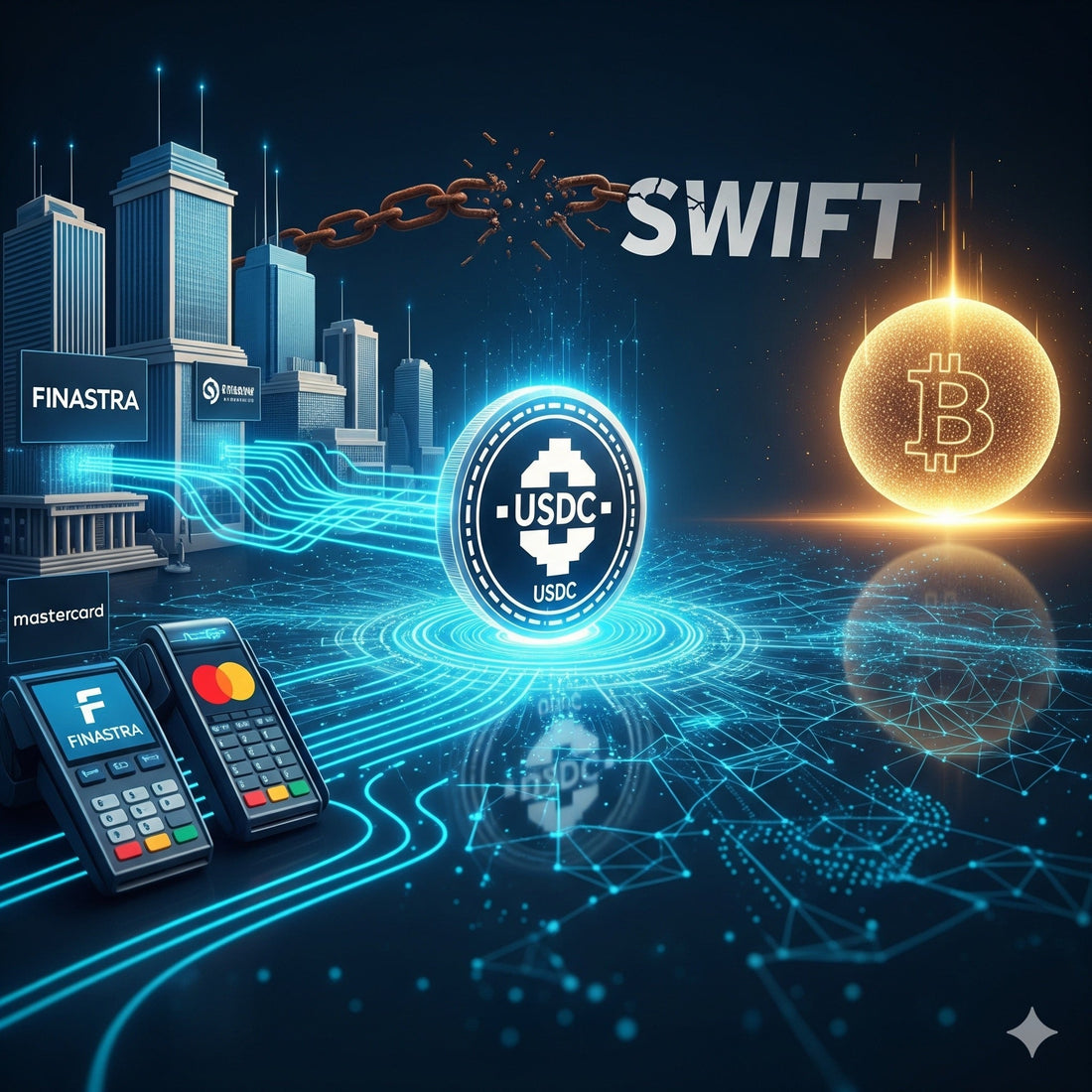
USDC Goes Prime Time: Circle, Finastra & Mastercard Are Embedding Stablecoins Into Banking
Share
USDC Goes Prime Time: Circle × Finastra × Mastercard
TL;DR: Stablecoins aren’t replacing banks—they’re being embedded inside them. That unlocks faster, programmable settlement while keeping compliance and FX intact. It changes how cross-border money moves, pressures correspondent banking, and accelerates a two-rail future: spend in dollars (USDC), save in scarcity (BTC).

The News (Clear and Simple)
- Finastra × Circle: Finastra will integrate USDC settlement into its Global PAYplus (GPP) payments hub. Banks can settle cross-border transfers in USDC even if the payment instructions stay in fiat.
- Mastercard × Circle: Mastercard will let acquirers and merchants in EEMEA (Eastern Europe, Middle East & Africa) settle in USDC and EURC; initial acquirer adopters include Arab Financial Services and Eazy Financial Services.
Translation: Stablecoin settlement is moving from pilots into the boring-but-critical middle of global payments infrastructure.
What This Collaboration Actually Does
For banks (via Finastra GPP): They can route cross-border flows through USDC for near-instant finality while preserving existing compliance (KYC/AML), sanctions screening, and FX processes. No need to rip-and-replace core systems.
For merchants & acquirers (via Mastercard): They can receive settlement in USDC/EURC on existing card rails. That gives faster access to funds, simpler cross-border operations, and bridges crypto liquidity with traditional acceptance.
What Most People Miss
- It’s integration, not replacement: The goal isn’t to kill banks—it’s to embed stablecoins into bank and network plumbing.
- Compliance stays intact: Fiat instructions and bank-grade controls remain, while settlement hops onto a faster, programmable rail.
- Programmability is the long game: Once embedded, you can automate escrow, rebates, vendor payouts, and trade-finance events natively in money.
- Silent pressure on correspondent banking: Fewer hops, fewer fees, fewer daylight gaps. SWIFT remains for messaging and reach, but the settlement “center of gravity” shifts.
What This Means for Banks (Right Now)
- Faster settlement + lower ops cost on cross-border flows without losing oversight.
- New products: USDC-based treasury, instant supplier payouts, programmable disbursements.
- Competitive pressure: As acquirers settle in stablecoins, corporates will expect similar speed from banks for payables/receivables.
- Risk to legacy fee pools: Correspondent fees, float, and FX spreads could compress where USDC rails take hold.
Active Investor Takeaways
- Stablecoins are becoming core infra: Watch adoption by banks/processors, not just crypto exchanges. Network effects in payments are durable.
- “Two-rail” thesis: Dollar-stable rails for working capital and payments; scarce, neutral assets (BTC) for savings and balance-sheet optionality.
- Pick the shovel sellers: Infra providers (bank software, compliance stacks, on/off-ramps) can scale with each new corridor.
- FX & remittance disruption: Corridors with weak USD liquidity or high fees are ripest for migration.
About the “XRP Will Run the World” Narrative
These specific announcements do not rely on XRP or Ripple’s network. They explicitly reference USDC/EURC settlement on existing bank and card rails. That doesn’t prevent Ripple or XRP from being used elsewhere, but this wave of integrations shows an institutional preference for regulated, fiat-pegged tokens that slot neatly into compliance and accounting.
Bottom line: There’s no single, ordained “one-coin” solution for global finance. In practice, multiple rails will coexist—and today’s move is a vote for fiat-pegged stablecoins inside legacy infrastructure.
Where Bitcoin Fits (and Why It Still Matters)
- Store of value & sovereignty: Stablecoins optimize dollars; Bitcoin optimizes self-custody, scarcity, and neutrality.
- Spend in dollars, save in sats: Let stablecoins handle invoices and payroll; hold BTC for long-term purchasing-power protection.
- Backstop: Stablecoins carry issuer/censorship risk. Bitcoin remains the permissionless exit.
Recommendation: Use stablecoins for working capital and settlement speed. Accumulate Bitcoin in self-custody for long-term sovereignty and optionality. Don’t confuse payment convenience with monetary independence.
Not investment advice. Do your own research and manage risk.
The Trend Line
We’re heading toward a multi-rail world: fiat rails, stablecoin rails, and crypto-native rails working side-by-side. The winners will be the networks and platforms that make those rails interoperable while keeping compliance, user experience, and capital efficiency front-and-center.


